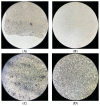Dispersion and Homogeneity of MgO and Ag Nanoparticles Mixed with Polymethylmethacrylate
- PMID: 36987259
- PMCID: PMC10056507
- DOI: 10.3390/polym15061479
Dispersion and Homogeneity of MgO and Ag Nanoparticles Mixed with Polymethylmethacrylate
Abstract
This study aims to examine the impact of the direct and indirect mixing techniques on the dispersion and homogeneity of magnesium oxide (MgO) and silver (Ag) nanoparticles (NPs) mixed with polymethylmethacrylate (PMMA). NPs were mixed with PMMA powder directly (non-ethanol-assisted) and indirectly (ethanol-assisted) with the aid of ethanol as solvent. X-ray diffraction (XRD), energy-dispersive X-ray spectroscopy (EDX), and scanning electron microscope (SEM) were used to evaluate the dispersion and homogeneity of MgO and Ag NPs within the PMMA-NPs nanocomposite matrix. Prepared discs of PMMA-MgO and PMMA-Ag nanocomposite were analyzed for dispersion and agglomeration by Stereo microscope. XRD showed that the average crystallite size of NPs within PMMA-NP nanocomposite powder was smaller in the case of ethanol-assisted mixing compared to non-ethanol-assisted mixing. Furthermore, EDX and SEM revealed good dispersion and homogeneity of both NPs on PMMA particles with ethanol-assisted mixing compared to the non-ethanol-assisted one. Again, the PMMA-MgO and PMMA-Ag nanocomposite discs were found to have better dispersion and no agglomeration with ethanol-assisted mixing when compared to the non-ethanol-assisted mixing technique. Ethanol-assisted mixing of MgO and Ag NPs with PMMA powder obtained better dispersion, better homogeneity, and no agglomeration of NPs within the PMMA-NP matrix.
Keywords: Ag; MgO; PMMA; dispersion; homogeneity; nanoparticles.
Conflict of interest statement
The authors declare no conflict of interest.
Figures













Similar articles
-
Effect of (Ag, Zn) co-doping on structural, optical and bactericidal properties of CuO nanoparticles synthesized by a microwave-assisted method.Dalton Trans. 2021 May 14;50(18):6188-6203. doi: 10.1039/d0dt04405a. Epub 2021 Apr 19. Dalton Trans. 2021. PMID: 33871499
-
Magnesium oxide nanoparticle-loaded polycaprolactone composite electrospun fiber scaffolds for bone-soft tissue engineering applications: in-vitro and in-vivo evaluation.Biomed Mater. 2017 Sep 25;12(5):055011. doi: 10.1088/1748-605X/aa792b. Biomed Mater. 2017. PMID: 28944766
-
Reducing the Crystallite Size of Spherulites in PEO-Based Polymer Nanocomposites Mediated by Carbon Nanodots and Ag Nanoparticles.Nanomaterials (Basel). 2019 Jun 9;9(6):874. doi: 10.3390/nano9060874. Nanomaterials (Basel). 2019. PMID: 31181863 Free PMC article.
-
Bioactivity of magnesium oxide nanoparticles synthesized from cell filtrate of endobacterium Burkholderia rinojensis against Fusarium oxysporum.Mater Sci Eng C Mater Biol Appl. 2020 Apr;109:110617. doi: 10.1016/j.msec.2019.110617. Epub 2019 Dec 31. Mater Sci Eng C Mater Biol Appl. 2020. PMID: 32229008
-
Green synthesis, characterization of silver nanoparticals for biomedical application and environmental remediation.J Microbiol Methods. 2022 Feb;193:106384. doi: 10.1016/j.mimet.2021.106384. Epub 2021 Nov 23. J Microbiol Methods. 2022. PMID: 34826520 Review.
References
-
- Elshereksi N.W., Ghazali M.J., Muchtar A., Azhari C.H. Perspectives for Titanium-Derived Fillers Usage on Denture Base Composite Construction: A Review Article. Adv. Mater. Sci. Eng. 2014;2014:746252. doi: 10.1155/2014/746252. - DOI
-
- Brinson H.F., Brinson L.C. Polymer Engineering Science and Viscoelasticity. Springer; Cham, Switzerland: 2015. Characteristics, applications and properties of polymers; pp. 57–100. - DOI
-
- Ahmed M.A., Ebrahim M.I. Effect of Zirconium Oxide Nano-Fillers Addition on the Flexural Strength, Fracture Toughness, and Hardness of Heat-Polymerized Acrylic Resin. World J. Nano Sci. Eng. 2014;4:50–57. doi: 10.4236/wjnse.2014.42008. - DOI
-
- Sakaguchi R.L., Powers J.M. Craig’s Restorative Dental Materials E-Book. Elsevier Health Sciences; Amsterdam, The Netherlands: 2012.
LinkOut - more resources
Full Text Sources
Miscellaneous

